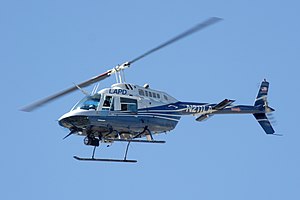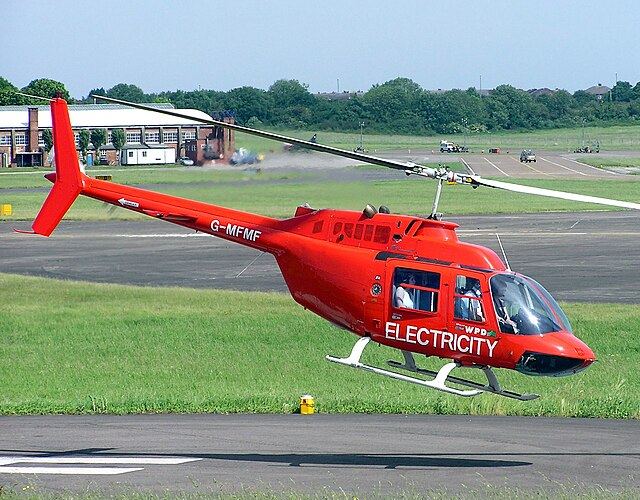Loading AI tools
Utility helicopter family by Bell From Wikipedia, the free encyclopedia
The Bell 206 is a family of two-bladed, single- and twin-engined helicopters, manufactured by Bell Helicopter at its Mirabel, Quebec, plant. Originally developed as the Bell YOH-4 for the United States Army's Light Observation Helicopter program, it was not selected by the Army. Bell redesigned the airframe and successfully marketed the aircraft commercially as the five-place Bell 206A JetRanger. The new design was eventually selected by the Army as the OH-58 Kiowa.
| Bell 206 JetRanger/LongRanger | |
|---|---|
 An LAPD Bell 206 JetRanger | |
| General information | |
| Type | Multipurpose utility helicopter |
| National origin | United States/Canada |
| Manufacturer | Bell Helicopter |
| Status | In service |
| Number built | 7,300[1] |
| History | |
| Manufactured | 1962–2017[2] |
| Introduction date | 1967 |
| First flight | December 8, 1962 (206)[3] January 10, 1966 (206A)[4] |
| Developed from | Bell YOH-4 |
| Variants | Bell OH-58 Kiowa |
| Developed into | Bell 407 |
Bell also developed a seven-place LongRanger, which was later offered with a twin-engined option as the TwinRanger, while Tridair Helicopters offers a similar conversion of the LongRanger called the Gemini ST. The ICAO-assigned model designation "B06" is used on flight plans for the JetRanger and LongRanger, and the designation "B06T" is used for the twin-engined TwinRangers.

On October 14, 1960, the United States Navy solicited responses from 25 aircraft manufacturers to a request for proposals (RFP) on behalf of the Army for the Light Observation Helicopter (LOH). Bell entered the competition along with 12 other manufacturers, including Hiller Aircraft and Hughes Tool Co., Aircraft Division.[5] Bell submitted the D-250 design, which would be designated as the YHO-4.[6] On May 19, 1961, Bell and Hiller were announced as winners of the design competition.[7][8]
Bell developed the D-250 design into the Bell 206 aircraft, redesignated as YOH-4A in 1962, and produced five prototype aircraft for the Army's test and evaluation phase. The first prototype flew on December 8, 1962.[3] The YOH-4A also came to be known as "The Ugly Duckling" in comparison to the other contending aircraft.[3] Following a fly-off of the Bell, Hughes and Fairchild-Hiller prototypes, the Hughes OH-6 was selected in May 1965.[9]
When the YOH-4A was eliminated by the Army, Bell went about solving the problem of marketing the aircraft. In addition to the image problem, the helicopter lacked cargo space and only provided cramped seating for the planned three passengers. The solution was a redesigned fuselage, sleeker and aesthetically appealing, adding 16 ft3 (0.45 m3) of cargo space in the process.[10] A Bell executive contributed to this redesign by drawing on a sketch two lines extending the fuselage to where it meets the tail.[11] The redesign was designated Bell 206A, and Bell President Edwin J. Ducayet named it the JetRanger, denoting an evolution from the popular Model 47J Ranger.
Bell Helicopter ended production of the Bell 206B-3 version in 2010.[12][2] In 2011, used 206B-3s sold for around $1.4 million depending upon the equipment and configuration.[13] Bell intends for the Bell 505 Jet Ranger X to replace the 206 five-seat versions from around 2015 and compete with the Robinson R66.[14]

The 206L LongRanger is a stretched variant with seating for seven. The fuselage, stretched a total of 30 inches (760 mm), adds two rear-facing seats between the front and rear seats. Since 1975, Bell has produced more than 1,700 LongRangers across all variant types. In 1981, a military version, the 206L TexasRanger was released. The original 206L used an Allison 250-C20B engine, and a series of model upgrades replaced this engine with more powerful versions; the 206L-1 used a 250-C28, and the 206L-3 and 206L-4 used the 250-C30P.
In both applications, the 250-C30P is derated from 650 hp for takeoff and 501 hp continuous. The 206L-3 is transmission-limited to 435 hp for take-off, and the 206L-4 is transmission-limited to 495 hp. The derating of the C30P produces an advantage in hot-day and high-altitude operations as it can produce the rated horsepower at higher altitudes and temperatures where applications that use the maximum rating of the engine at sea level suffer accelerated performance deterioration with increases in temperature and altitude. The 206L-3 and L-4 have not been offered in a twin configuration under those model designations.[citation needed]
In 2007, Bell announced an upgrade program for the 206L-1 and 206L-3 which is designed to modify the aircraft to the 206L-4 configuration; modified aircraft are designated 206L-1+ and 206L-3+. Modifications include strengthened airframe structural components (including a new tailboom), improved transmission, upgraded engine for the L-1, all of which result in a maximum gross weight increase of 300 pounds and increased performance.[15]
Production of the 206L-4 ended in June 2017 with over 3800 LongRanger's produced.[2]
The TwinRanger name dates from the mid-1980s when Bell developed the Bell 400 TwinRanger, but it never entered production.[16]
In 1989, Tridair Helicopters began developing a twin-engine conversion of the LongRanger, the Gemini ST. The prototype's first flight was on January 16, 1991, while full FAA certification was awarded in November. Certification covers the conversion of LongRanger 206L-1s, L-3s and L-4s to Gemini ST configuration.[16] In mid-1994 the Gemini ST was certificated as the first Single/Twin aircraft, allowing it to operate either as a single or twin engine aircraft throughout all phases of flight.[16]
The Bell 206LT TwinRanger was a new-build production model equivalent to Tridair's Gemini ST, and was based on the 206L-4. Thirteen 206LTs were built, the first being delivered in January 1994, and the last in 1997. The TwinRanger was replaced in Bell's lineup by the mostly-new Bell 427.[16]

The first Bell 206A flew on January 10, 1966, and the aircraft was revealed later that month at the Helicopter Association of America (HAA) convention. On October 20, 1966, the JetRanger received FAA certification. Delivery of the JetRanger to customers began on January 13, 1967, with the first aircraft being purchased by Harry Holly, CEO of the Hollymatic Corporation and previous owner of a Bell Ranger.[10] In 1968, the United States Navy selected the 206A as its primary trainer, the TH-57 Sea Ranger. The Army also eventually selected the 206A for a light observation helicopter as the OH-58 Kiowa.
The basic shape and design of the JetRanger remained unchanged since 1967, but Bell introduced the 206B JetRanger II in 1971. In 1977, the 206B-3 JetRanger III was introduced with its modified tail rotor and more powerful engine. The JetRanger is popular with news media for traffic and news reporting. The LongRanger is commonly used as an air ambulance and as a corporate transport. On September 1, 1982, pilots H. Ross Perot, Jr. and Jay Coburn departed Dallas, Texas in the "Spirit of Texas", a Bell 206L-2 (N3911Z). They returned on 30 September, 29 days and 3 hours later, completing the first around-the-world helicopter flight.[17]
The Bell 206B was first introduced to the Canadian market shortly after its certification in 1967. Its early adoption was driven by the booming resource industries of the time, particularly in oil and gas exploration, mining, and forestry. Its light weight, combined with the ability to land in rugged, remote locations, made it an ideal tool for transporting geologists, surveyors, and equipment to otherwise inaccessible areas of Canada's vast wilderness.
In the 1970s and 1980s, the JetRanger became a critical part of exploration in northern Canada, including the Yukon, Northwest Territories, and Arctic regions, where harsh weather conditions and rough terrain demanded a helicopter that could perform in all environments. The Bell 206B's durability and low operating cost also made it a favorite for these long, sometimes dangerous missions.[18]
In 1983, Australian businessman Dick Smith became the first helicopter pilot to complete a solo trip around the world in 260 flight hours. During the trip, he landed his 206B-3 (S/N 3653; VH-DIK) on prepositioned container ships to refuel between Japan and the Aleutian Islands.
In 1993, the U.S. Army chose the Bell 206B-3 as the winner of the New Training Helicopter competition, to serve as its primary training helicopter, the TH-67 Creek. The number of TH-67s being divested by the Army is too small to impact civilian markets.[19]
On July 22, 1994, Ron Bower landed his 206B-3 (N206AJ) at Hurst, Texas, setting a new record for around-the-world flight by a helicopter. Bower had departed on June 24 and returned 24 days, 4 hours, 36 minutes and 24 seconds later, averaging 35.62 knots (40.99 mph, 65.97 km/h).[20] Bower had added a 91-US-gallon (340 L) auxiliary fuel tank, which doubled the JetRanger III's range.[21]
On August 1, 1977, famous U-2 spy plane pilot Francis Gary Powers was piloting a helicopter for KNBC Channel 4 over West Los Angeles, California, when the aircraft crashed, killing him and cameraman George Spears. They had been video recording brush fires in Santa Barbara County in the station's helicopter and were leaving the area.[22]
On August 27, 1990, musician Stevie Ray Vaughan, pilot Jeff Brown, and three members of Eric Clapton's crew, Bobby Brooks, Nigel Browne, and Colin Smythe, were killed in a 206B crash.[23]
On October 25, 1991, a Bell 206 carrying rock music concert promoter Bill Graham, his girlfriend Melissa Gold, and pilot Steve Kahn crashed into a transmission tower west of Vallejo, California, killing everyone on board.[24][25] The cause of the accident was determined to be the pilot's intentional flight into known adverse weather conditions.[26][importance?]
On January 12, 1994, an Agusta-Bell 206A-1 crashed while attempting to land at the helipad of the Central Command headquarters in Neve Yaakov, killing all four occupants on board, including IDF Major General Nehemiah Tamari.[27][28]
On March 9, 2009, Bangladesh Army aviation unit Bell 206L flown by pilot Lt Col MD Shahidul Islam and co-pilot Major Saif crashed at Rouha in Kalihati sub-district. The helicopter was carrying General Officer Commanding of 55 Infantry Division and Jessore Area Commander Maj Gen Rafiqul Islam. Maj Gen Islam and pilot Lt Col Islam died in the crash while co-pilot Major Saif sustained serious injuries.[29]
On August 20, 2014, Guatemala's Chief of the General Staff of the Armed Forces Rudy Ortiz was killed when his Bell 206 crashed.[30]
On February 11, 2019, Brazilian journalist Ricardo Boechat and the pilot were killed when Bell 206B, PT-HPG, crashed into a truck while attempting an emergency landing on a highway.[31]





The Bell 206 has been popular for all types of uses both commercial and private.












Data from Jane's All The World's Aircraft, 1966-1967[77]
General characteristics
Performance
Related development
Aircraft of comparable role, configuration, and era
Related lists
Seamless Wikipedia browsing. On steroids.
Every time you click a link to Wikipedia, Wiktionary or Wikiquote in your browser's search results, it will show the modern Wikiwand interface.
Wikiwand extension is a five stars, simple, with minimum permission required to keep your browsing private, safe and transparent.